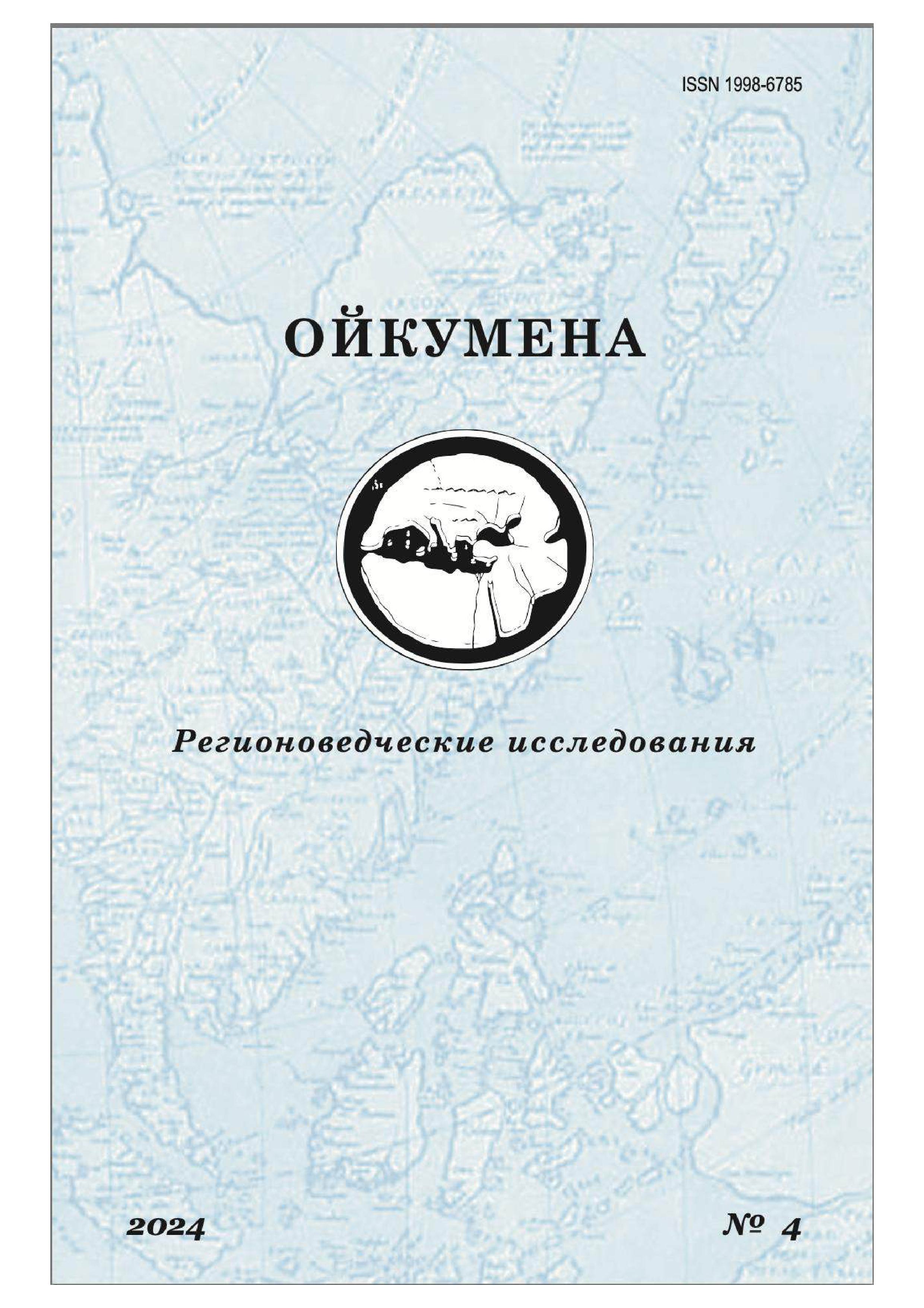The article presents a general overview of the development of traditional cattle breeding in the Russian-Mongolian transborder area in the post-socialist period. The authors note the symmetry of the processes on both sides of the border, characterized by the revival of low-cost pasture livestock farming as a response to the challenges of the transition period. Identical processes are observed between Mongolia and remote areas of Buryatia (Russia), where there has been a return to the traditional pasture-based type of animal husbandry. The modern practice of nomadism in Mongolia has a general tendency towards a lower degree of mobility and sedentariness. Semi-nomadic farming is becoming an increasingly common form as a result of the adaptation of livestock farming to market conditions and the environmental and climatic conditions of the arid zone of the Russian-Mongolian transborder.
cattle breeding, cross-border, nomadic economy, Mongolia, Buryatia
1. Badaraev D. D. The Traditional Economic Practices of Mongolian-Speaking Nomads: peculiarities and Opportunities for the Development of Livestock Farming in Mongolia’s and Russia’s Adjacent Territories. // Bulletin of the Institute of Sociology. 2016. Vol. 7. No. 3. P. 175–194. (In Russ.). DOI: https://doi.org/10.19181/vis.2016.18.3.420; EDN: https://elibrary.ru/WXBKWV
2. Bajanova T. O., Biuraeva J. G. Socio-economic Aspects of Development of Agrarian Sector of Economy of the Republic of Buryatia // Globalizacija i mongol’sky mir [Globalization and Mongolian World]: conference papers. Ulan-Ude, BSC SB RAS publ., 2010. P. 59–60. (In Russ.).
3. Buryatia and Mongolia signed an act on the completion of the delivery of humanitarian aid to Mongolian herders // Representative Office of the Russian Foreign Ministry in Ulan-Ude. URL: https://buryatia.mid.ru/ru/press-centre/news/buryatiya_i_mongoliya_postavki_gumanitarnoy_pomoshchi_mon-golskim_skotovodam/ (accessed 02.10.2024). (In Russ.).
4. The best project in agriculture in recent years was named in Buryatia // MK in Buryatia (30.04.2023). URL: https://ulan.mk.ru/economics/2023/07/30/v-buryatii-nazvali-luchshiy-za-posled-nie-gody-proekt-v-selskom-khozyaystve.html (accessed 10.10.2024). (In Russ.).
5. Gomboev B. O. Pastural Land-use in Inner Asia / B. O. Gomboev; otv. red. A. K. Tulohonov, Ju.P. Mihajlov; Ros. akad. nauk, Bajkal'skij in-t prirodopol'zovanija. Novosibirsk: Izd-vo SO RAN, 2006. 228 p. (In Russ.). EDN: https://elibrary.ru/QRMNVZ
6. Grajvoronsky V. V. Changes in the Social Standard of Living in Buryatia (Russia), Mongolia and Inner Mongolia (China) at the End of 20th – Beg. of 21st Cent. Ulaanbaatar: 2013. 284 p. (In Russ.). EDN: https://elibrary.ru/NRIPZY
7. Grayvoronsky V. V. Mongolia at the Early of XXI century: Politics, Economy, Society. Moscow, 2017. 352 p. (In Russ.).
8. Grajvoronsky V. V. Modern Arats of Mongolia: Social Problems of the Transition Period (1980- 1995). Moscow: Publishing House "Vostochnaja literatura" RAN, 1997. 184 p. (In Russ.).
9. Zhambalova S. G. Nomadism in the Contemporary World: Problems of Traditional and Modernization // Uchenye Zapiski Zabaikalskogo Gosudarstvennogo Universiteta. 2012. № 2(43). P. 142–149. (In Russ.). EDN: https://elibrary.ru/OZKUKZ
10. Kradin N. N. The Transformations of Pastoral Economy in Tuva and Zabaikalie Region at the Turn of the XX – XXI Centuries // Etnograficheskoe obozrenie. 2016. No. 2. P. 8–27. (In Russ.). EDN: https://elibrary.ru/VXCBIJ
11. Kradin N. N. Transformation of the Livestock Farming of the Agin Buryats in the Early XXI Century: A Comparative Analysis 2014. // Vestnik Rossiyskogo gumanitarnogo nauchnogo fonda. P. 205–214. (In Russ.). EDN: https://elibrary.ru/UCTCHT
12. Mihalev M. S. The Great Eastern Limitrophe. Transborder Peoples in the State Policy of China and Russia. M.: Vostochnaja literatura, 2022. 293 p. (In Russ.).
13. The Mongolian World: Between East and West / edited by Yu. V. Popkov, J. Amarsana. Novosibirsk: Avtograf, 2014. 351 p. (In Russ.).
14. Rassadin I. V. Comparative Analysis of the Soyots and Buryats Livestock Breeding // Humanitarian Vector. 2017. Vol. 12, No. 4. P. 190–195. (In Russ.). EDN: https://elibrary.ru/ZEKBFJ
15. Rinchinova O. S. Buryat Diaspora in Mongolia: Stages of Formation and Development // Diss…Cand. of History. Ulan-Ude, 2011. (In Russ.). 170 c.
16. Agriculture and Forestry, Fisheries and Fish Farming // Territorial body of the Federal State Statistics Service for the Republic of Buryatia. URL: https://03.rosstat.gov.ru/storage/mediabank/ege2023_17.pdf (accessed 10.10.2024). (In Russ.).
17. Sinitsyn F. L. Transboundary Nomadism in the USSR in the 1920s // Vestnik Rossijskogo universiteta druzhby narodov. Serija: Istorija Rossii. 2019. T. 18. №3. C. 589-604. (In Russ.). DOI: https://doi.org/10.22363/2312-8674-2019-18-3-589-604; EDN: https://elibrary.ru/THAULZ
18. Tsetsenbileg Ts. Problems of Modernization of Mongolian Society. Ulaanbaatar, 2002. 148 p. (In Mongol.)
19. Chojropov C. C. Traditional (nomad) livestock farming of the indigenous peoples of Transbaikalia: history and modernity // Proc. of the Conf. "Problemy i perspektivy social'no-jekonomicheskogo ijetnokul'turnogo razvitija korennyh malochislennyh narodov Severa: Sociologija, prirodopol'zovanie, istorija i jetnologija, Hanty-Mansijsk, 28–29, May, 2014". Hanty-Mansijsk: OOO "MAKS-PRINT", 2015. P. 183–193. (In Russ.). EDN: https://elibrary.ru/ZUHRGT
20. Enkhtuvshin B. Some Issues of the Traditional Culture of the Nomads of Mongolia: Modernity and Prospects // The World of Central Asia – 3. Ulan-Ude, Irkutsk: Ottisk, 2012. P. 23–25. (In Russ.).
21. Yadov V. A. Post-Soviet Societies Transformations: What is More Significant – the Historically Traditional or Recent Past? // Sociological studies. 2014. No. 7. P. 47–50. (In Russ.). EDN: https://elibrary.ru/SMHNQX
22. Gundsambuu H. Social stratification of Modern Mongolia: development, trends (XX century). Ulaanbaatar, 2002. 660 p. (In Mong.).
23. Number of Livestock, by type, by country, region, province, capital, sum, district, by group, by district, by year // United Statistical Database. URL: https://www.1212.mn/mn/statistic/statcate/573054/table-view/DT_NSO_1001_021V1 (accessed 02.10.2024) (In Mong.).
24. Bazarov B. Transformation of Nomadic Society: Comparative Analysis of Social and Economic Development of Mongolian Peoples at the End of XX – beginning of XXI Centuries. Nomadic Studies. 2005. № 10. P. 11–13.
25. Humphrey C., Sneath D. The end of Nomadism?: Society, state, and the environment in Inner Asia. Duke University Press, 1999. 368 p.
26. Marchina C. Nomadic Pastoralism among the Mongol Herders: Multispecies and Spatial Ethnography in Mongolia and Transbaikalia. Amsterdam University Press, 2021. 178 p.
27. Shaglanova O. A. The "Borderlands Milieu" between Russia and Mongolia: A History of Settlement and Transnational Interactions // Senri Ethnological Studies. 2016. Vol. 92. P. 123–141.











